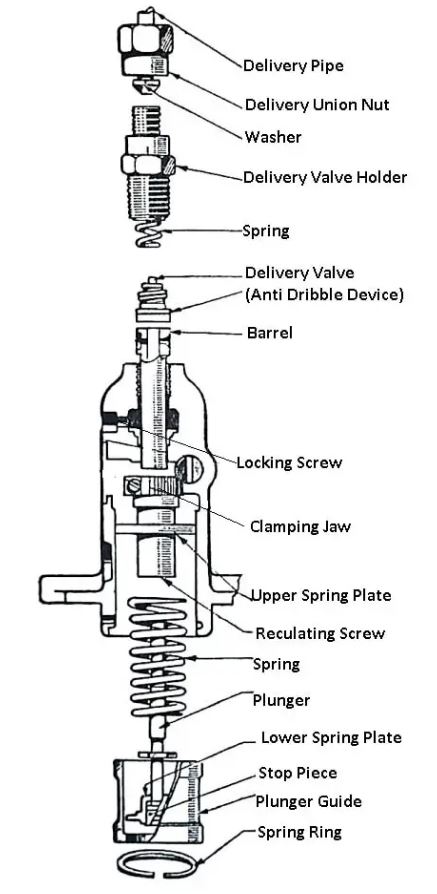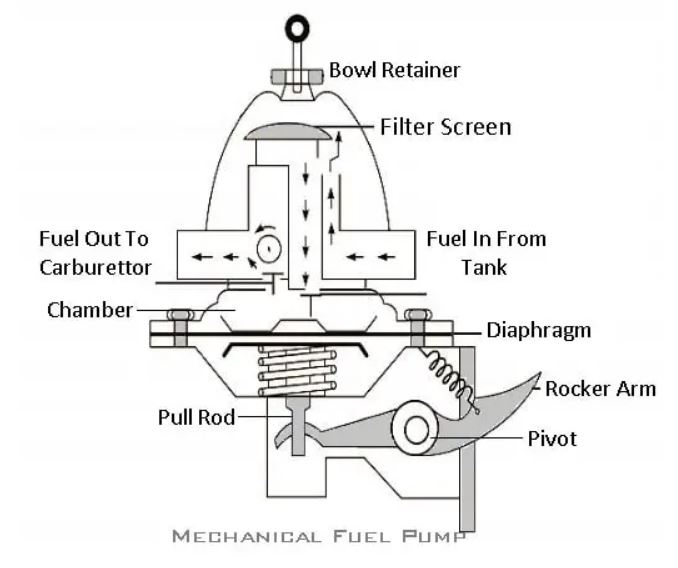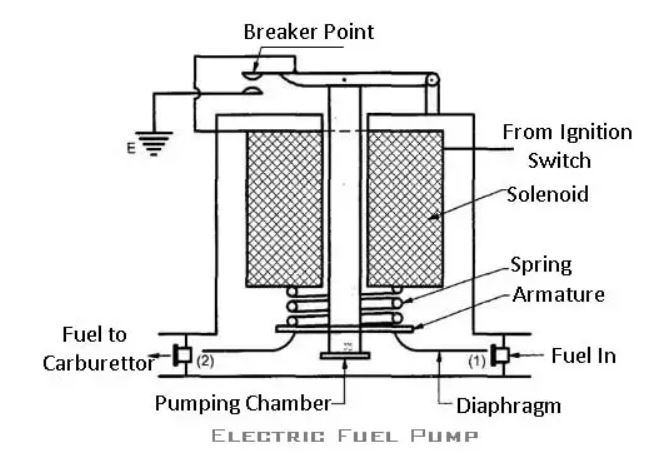In this article, you’ll learn about fuel pumps, the types of fuel pump, and their working principle.
What is a Fuel Pump?
The purpose of the fuel pump is to meter the correct quantity of fuel and deliver it at the correct time to the engine cylinder according to the varying load and speed requirements.
This pump will force the fuel from the tank into the combustion chamber. The fuel is then transformed into energy, which aids in starting the car’s engine. However, depending on the type of vehicle, its functions can be expanded.
The fuel pump has two functions in the automotive sector, depending on the type of vehicle. In an injection system car, the fuel pump transfers fuel from the tank to the injectors. It transfers fuel from the tank to the carburetor on the vehicle using the carburetor system.
Construction and Working of a Fuel Pump
The plunger is driven by a cam and tappet mechanism at the bottom. It reciprocates in the barrel. There are as many plungers as the number of cylinders in the engine. The plunger has a rectangular vertical groove.
The delivery valve is lifted off its seat under the fuel pressure against the spring. The fuel from the delivery valve goes to the injector. When the plunger is at the bottom of its stroke, the supply port and spill are uncovered, and the fuel from a low-pressure pump after filtration is forced into the barrel.

Working
Now the plunger is pushed up by the cam movement and both the parts are closed. On further movements of the plunger, the fuel above it is compressed which lifts the delivery valve, and the fuel through it goes to the injector.
The plunger rises still further, and at a particular moment, the helical groove connects the spill port, through the rectangular groove to the fuel in the upper part of the plunger.
Consequently, there is a sudden pressure drop due to which the delivery valve falls back on its seat under the spring force. The pressure in the delivery pipe also drops. Thus the discharge from the nozzle of the injector is cut off suddenly. The cycle is repeated again and again.
During each stroke of the plunger, the delivery duration is more or less according to the spill port made to communicate earlier or later, the high-pressure fuel in the upper part of the barrel. This depends upon the position of the helical groove which can be changed by rotating the plunger by the rack.
The rack is connected to the accelerator. It meshes with a geared quadrant. The motion of the rack rotates the gear quadrant which ultimately rotates the plunger. The driver simply operates the accelerator which controls the fuel supply to the engine cylinder.
Read also: What is steering system? and how it works? [The complete guide]
Types of Fuel Pump
The fuel pump is used in the
Two general types of fuel pump are as follows:
- Mechanical Fuel Pump
- Electrical Fuel Pump
The performance of
For the volume test, disconnect the fuel from the carburetor and run the engine at idling speed. Measure the volume of fuel coming out from the pump by collecting it in a separate container.
For a vacuum test, connect a suitable vacuum gauge between the gauge tank and then run the engine at idling speed. The gauge indicates the vacuum generated inside the pump to suck the fuel from the fuel tank.
The vacuum must be retained for at least ten seconds after closing the engine. The fuel pump found connected in the above three tests should be used in the fuel system.
Mechanical Fuel Pump
The mechanical fuel pump is operated by an eccentric on the engine camshaft. It is mounted on the side of the cylinder block inline engines. In some V-8 engines, it is fitted between the two-cylinder banks.

Construction and Working of Mechanical Fuel Pump
The figure shows a diaphragm-type A.C. mechanical fuel pump it is bolted to the engine block or crankcase so that the rocker arm slides on a pump operating can on the engine camshaft or in front of the timing gear or timing chain sprocket.
It consists of a
As the cam rotates, it operates the rocker arm which in turn pushes the diaphragm up and down. The downward movement of the diaphragm sucks the fuel through the strainer from the fuel tank. The upward movement of the diaphragm pushes the fuel up which causes the inlet to close an outlet valve to open. The fuel through the outlet valve goes to the carburetor.
If the float
To avoid this, the connection between the rocker arm and the pull rod is made flexible with the help of springs. When the fuel
Thus although the cam is running
Read also: Basic Engine Components (Engine Parts Names and Pictures)
Electric Fuel Pump

The electrical fuel pump is mounted in the fuel tank. It contains an impeller which is driven by an electric motor. This pushes the fuel through the fuel line to the carburetor. Another type of electric fuel pump is mounted in the engine compartment.
The figure shows an S.U.elcetric fuel pump. It also consists of a diaphragm, but it is operated
The upward movement of the diaphragm creates suction, and the fuel is drawn
The fuel
Diaphragm Type Fuel Pump
The diaphragm-type fuel pump is a positive displacement pump that draws fuel through the expansion and compression of the diaphragm. The pump body is made up of one-way check valves at the intake and outlet.
As the diaphragm compresses, the pressure within the pump falls below atmospheric pressure, and fuel is drawn through the inlet valve. The diaphragm expanded, forcing the fuel inside the pump out via the output valve.
The diaphragm expands and contracts by a lever that is actuated by an eccentric cam motion. The crankshaft of the engine is connected to this eccentric cam via an appropriate gearing configuration.
High-Pressure Fuel Pump
To directly inject fuel into the combustion chamber of combustion ignition engines, these pumps are frequently used. These types of fuel pump run at pressures higher than 200 Pascals. These high-pressure pump systems require more complexity and durability.
That is it, thanks for reading. If you have any questions about the “types of fuel pump” ask in the comments. If you like this article share it with your friends.
Subscribe to your newsletter to get notified when we upload new posts.
Download PDF of this article:
Read Next:
- Spark Plug: Types, Parts, Working Principle, Applications with (PDF)
- What are the different types of ignition system? PDF
- Types of Cooling System in Automobile Engines [Explained with PDF]
FAQs
The automotive fuel pump module is made up of a motor, a gear pump, a pressure damper, and a discharge valve to prevent overpressure damage.
Fuel consumption is reduced with an electric fuel pump since there is no mechanical drive or resistance associated with it. It is also possible to control the fuel supply much more efficiently by separating the fuel pump from the engine’s mechanical system.
Fuel can be contaminated by corrosion, dirt, and moisture, which can introduce visible pollutants into the tank. This could cause the fuel pump to malfunction.
It’s likely impossible to drive your car if the fuel pump is faulty. Replace the fuel pump if the vehicle won’t start. After letting the engine cool down, try starting the car.
can i have the PDF please
The PDF file has been sent to your inbox.
Can you send me the PDF format
I just sent you the PDF file to your inbox.
Can u send me the pdf format
The PDF file has been sent to your inbox.
Please send the PDF file
The PDF file has been sent to your inbox.
Thank You
You’re welcome.
Can u send me PDF to email
I have sent the PDF file to your inbox.
Can you send me the PDF please
The PDF file has been sent to your inbox.